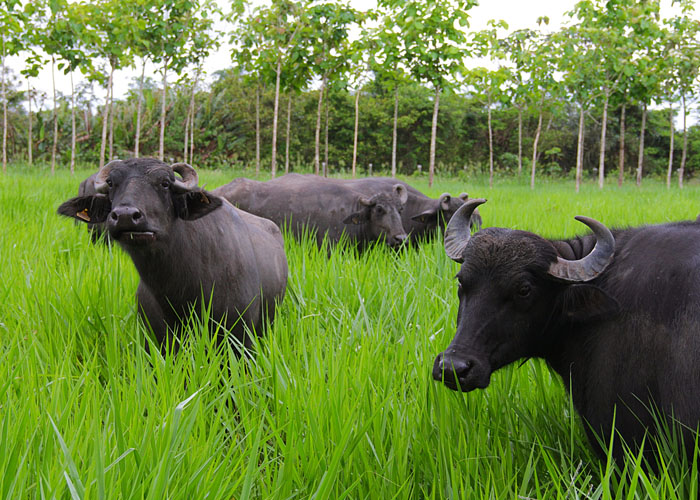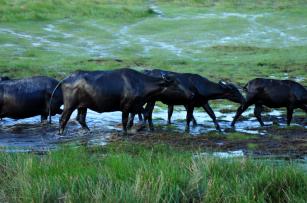Buffalo meat has almost 50% less fat than beef
Buffalo meat has almost 50% less fat than beef
Studies developed by two of the corporation's research units in Rio Grande do Sul state, Embrapa South Livestock and Embrapa Temperate Agriculture, have shown that buffalo meat is almost 50% leaner than beef. They analyzed the physical-chemical qualities of the meat of 50 animals of the Murrah breed, which, combined with the Mediterranean, are among the top most used by buffalo breeders in Brazil.
Preliminarily, the studies demonstrate that the average fat content of buffalo meat is of only 1.29%, while grass-fed beef has 2.25%. This result can contribute to expanding and diversifying the market for buffalo products in the country, which today is much more focused on milk, whose growth surpasses 20% a year.
The studies also revealed that buffaloes' carcass yield is similar to bovines' (47.7%). The Embrapa South Livestock researcher Élen Nalério explains that since 2016 they have been assessing carcasses of animals slaughtered at 27 months. The collected meat samples have been examined at Embrapa South Livestock's Laboratory of Meat Science and Technology.
According to her, cholesterol levels are at an assessment stage. "We are optimistic with the preliminary data, which seem quite positive. Our intention is, in the end, to make the nutritional characterization of buffalo meat, which can be an extra selling point for consumers who seek foods with low fat content", she states.
With regard to the tenderness requirement, which is based on muscle fiber shearing tests, the meat was not considered very tender. "This finding was probably due to the animals' advanced age, which were over 27 months old. We believe that, if it were steers, with about 18 months of age, the tenderness would be higher, which we will also assess", she concludes.
Selection and breeding
The work carried out in the South is part of a project entitled "Genetic analyses for the selection of buffalos (Bubalus bubalis) for milk and meat", led by Embrapa Eastern Amazon. Besides the sensorial and physical-chemical analysis of the meat, the research also aims to help farmers improve the genetics of the animals through selection.
The main traits that are sought after are, for the time being, those related to growth. It also includes the genetic evaluation of carcasses through ultrasound to make the selection of breeder animals.
With regard to milk, the breeding considers production data and assessment of the product quality. Embrapa Temperate Agriculture has collected samples every 28 days, since 2012, with the aim of analyzing the chemical composition of milk (fat, protein, lactose, total solids); somatic cell count (SCC) and standard plate count (SPC); and evaluate the instability of milk through the alcohol test; acidity, through the Dornic method; and density.
At the second stage of the project, the assessments pointed to an improvement in milk weight, with increased fat levels. The amount varied between 5% and 6%, in comparison with 3% in cow milk. Milk fat not only has important characteristics as food, but also plays a relevant role in the industry.
Herd figuresAccording to 2017 data by the Ministry of Agriculture, Livestock and Food Supply (Mapa), Rio Grande do Sul has a buffalo herd of around 58,000 head, in comparison with the 13.2 million bovines raised in the state. According to the data, there are 1.3 million buffaloes and more than 217 million bovines. The state of Pará concentrates the largest buffalo herd, with over 500,000 head. Infographics: IBGE |
Buffalo milk costs twice as much as cow one
With regard to production, the annual average obtained per female buffalo is of around five liters daily, when milked once a day, and eight liters a day when milked twice. Despite being lower than the bovine yield, which is of 15 liters a day on average, buffalo milk is better compensated - the price paid by the industry can reach twice the price of cow milk - and its byproducts have greater added value.
Moreover, the buffalo milk also yields more in processing. "In comparison with bovine milk, it offers a yield that can be 50% higher, especially in the elaboration of cheeses, such as mozzarella", explains the Embrapa Temperate Agriculture researcher Maria Cecilia Damé, responsible for the work.
The results have also shown an improvement in milk quality, as problems are identified and solved. It is the case of instability during the alcohol test, which occurs due to nutritional problems and mastitis, generally resulting from a badly regulated milking machine.
In terms of composition, buffalo milk protein levels range from 4% to 4.4%; lactose, from 4% to 5%; and total solids, from 16% to 17%. Such information, both about milk and meat production and quality, supplies a database that, after the evaluation, will allow the identification of animals of more productive lineages for meat and for milk.
The main problem identified with regard to the herd's health is the high mortality of the calves, which nears 20% due to gastrointestinal parasites. They should be controlled, according to the researcher Maria Cecilia, through the application of antiparasitic drugs based on monthly fecal exams.
Translation: Mariana Medeiros
Manuela Bergamim (MTb 1951/ES)
Embrapa South Livestock
Press inquiries
pecuaria-sul.imprensa@embrapa.br
Phone number: (53) 3240.4670
Francisco Lima (MTb 13696/RS)
Embrapa Temperate Agriculture
Press inquiries
clima-temperado.imprensa@embrapa.br
Phone number: +55 53 3275-8113 | 53 9161-5949
Further information on the topic
Citizen Attention Service (SAC)
www.embrapa.br/contact-us/sac/


